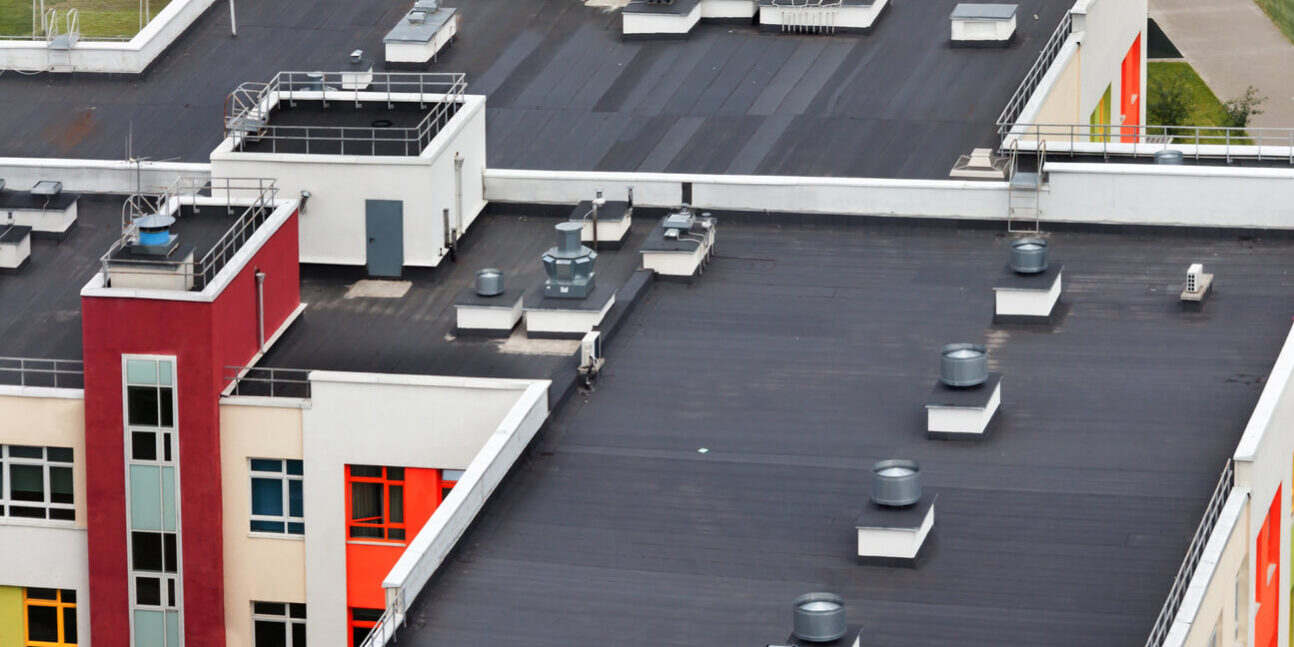Flat roofs have gained immense popularity in recent years for their sleek, modern look and practical benefits. While they are widely used in commercial buildings, they are also a viable option for residential properties. If you’re considering installing or replacing a flat roof, it’s essential to understand the different types available and their unique characteristics. This blog delves into the various types of flat roofs, their benefits, and their ideal applications, making it easier for you to make an informed decision.
What is a Flat Roof?
A flat roof, as the name suggests, appears nearly level but usually has a slight slope (around 1/4 inch per foot) to allow for water drainage. Unlike pitched roofs, flat roofs offer a minimalist design, making them suitable for modern architecture. Despite their aesthetic appeal, flat roofs require careful selection of materials and proper maintenance to ensure longevity and performance.
Built-Up Roofing (BUR)
Built-Up Roofing, commonly known as BUR, is one of the oldest and most trusted flat roofing systems. It consists of multiple layers of asphalt, felt, and tar, topped with a layer of gravel.
Built-up roofing offers exceptional durability and waterproofing. The gravel layer protects the roof from UV rays and harsh weather conditions while providing excellent insulation. This type of roofing is particularly suitable for commercial buildings and industrial spaces, where longevity and reliability are crucial.
BUR remains a cost-effective solution for large-scale installations, and its layered structure ensures resistance to mechanical damage, making it a reliable choice even in demanding environments.
Modified Bitumen Roofs
Modified Bitumen is an evolution of BUR, incorporating additional polymers for enhanced elasticity and strength. This type of roof can be installed using heat or self-adhesive sheets.
One of the primary benefits of modified bitumen roofs is their flexibility and resistance to cracking, even in extreme temperatures. This feature makes them ideal for regions with significant temperature fluctuations. Additionally, they are easy to install and repair, and their durability against foot traffic makes them a great choice for roof decks.
Homeowners and businesses looking for a resilient and low-maintenance roofing option often choose modified bitumen. Its polymer-enhanced construction ensures a strong bond and resistance to environmental wear, making it a versatile solution for various property types.
Single-Ply Membranes
Single-ply membranes are lightweight, easy to install, and growing in popularity. These roofs use large sheets of synthetic materials, such as TPO, PVC, or EPDM, each offering distinct advantages.
- TPO (Thermoplastic Polyolefin): Known for its energy efficiency and affordability.
- PVC (Polyvinyl Chloride): Durable and resistant to chemicals, making it ideal for commercial properties.
- EPDM (Ethylene Propylene Diene Terpolymer): A rubber-based option with excellent weather resistance.
Single-ply membranes provide seamless installation, minimizing the risk of leaks. Their reflective properties reduce heat absorption, which helps lower cooling costs. These roofs are perfect for properties prioritizing functionality and energy efficiency while maintaining a sleek appearance.
Green Roofs
Green roofs transform flat surfaces into eco-friendly spaces by covering them with vegetation over a waterproof membrane. These roofs improve air quality, reduce stormwater runoff, and offer excellent insulation.
Ideal for urban settings, green roofs provide a natural retreat while addressing environmental challenges like urban heat islands. Property owners seeking sustainable and aesthetically pleasing solutions often opt for green roofs, which can be customized with plants ranging from grasses to shrubs. This innovative approach to roofing benefits both the building and the community.
Spray Polyurethane Foam (SPF) Roofs
SPF roofing is a seamless system created by spraying liquid material that expands into foam. Once cured, it forms a durable, insulating layer.
The key advantage of SPF roofs is their seamless application, which eliminates joints and reduces the risk of leaks. They also provide exceptional thermal insulation, making them energy-efficient. Lightweight and adaptable to various roof shapes, SPF roofs are suitable for both residential and commercial properties.
SPF roofs are particularly beneficial for irregularly shaped roofs or those requiring added insulation. Their waterproof and insulating properties make them a reliable and long-lasting option for property owners.
Flat Metal Roofs
Flat metal roofs are crafted from materials like aluminum, steel, or copper, offering a sleek look and remarkable durability. These roofs can last over 50 years with proper care.
Flat metal roofs are highly resistant to weather damage and reflect sunlight, reducing cooling costs. Their recyclable materials make them an environmentally conscious choice for modern properties. Property owners looking for longevity and minimal maintenance often choose flat metal roofs, especially in regions with extreme weather conditions.
Hybrid Flat Roofs
Hybrid flat roofs combine features from different roofing systems to achieve optimal performance. For example, a hybrid roof may include a BUR base with a single-ply membrane for added protection.
The customization potential of hybrid roofs allows them to meet specific property needs, enhancing durability and versatility. By combining materials, these roofs address multiple challenges, such as energy efficiency, weather resistance, and aesthetics. Hybrid flat roofs are an excellent choice for complex roofing projects.
Choosing the Right Flat Roof for Your Property
Selecting the best flat roof depends on several factors:
- Budget: Consider upfront costs and long-term maintenance expenses.
- Climate: Choose materials suitable for your region’s weather conditions.
- Purpose: Determine whether the roof will be functional or solely protective.
- Aesthetics: Some materials offer a sleek, modern appearance, while others align with traditional designs.
- Longevity: Evaluate the lifespan of each roofing type to meet your expectations.
By weighing these factors, you can choose a roofing system that aligns with your needs and preferences, ensuring optimal performance and durability.
Maintaining Flat Roofs
Flat roofs require regular maintenance to ensure longevity and functionality. Here are key tips:
- Inspect the roof for leaks or damage at least twice a year.
- Clear debris to prevent drainage blockages.
- Apply protective coatings to enhance durability.
- Schedule professional inspections for early issue detection.
Routine maintenance helps prevent costly repairs, prolonging the life of your flat roof and ensuring reliable performance.
Conclusion
Flat roofs are a versatile and modern solution for both residential and commercial properties. With options ranging from traditional BUR to innovative green roofs, there’s a flat roof for every need and budget. Understanding the unique features and benefits of each type empowers you to make an informed decision.
If you’re considering a flat roof installation or upgrade in Katy, TX, Surface Roofing is here to assist. Our expert team specializes in a variety of flat roofing solutions, delivering quality and durability tailored to your needs. Contact us today to explore your options and schedule a consultation!







